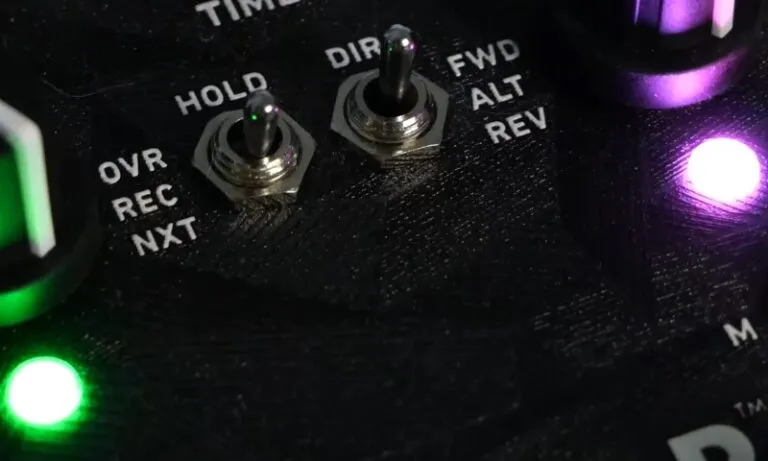If you’ve decided to play 7-string guitars, you’re in for a treat. The additional string adds a whole new dimension to your playing, offering an expanded range and a rich array of tones.
Let’s break down how to make the most out of your 7-string guitar with a focus on tuning, setup, and maintenance.
Table of Contents
ToggleWhy a 7-String Guitar Is a Very Cool Option
A 7-string guitar includes an extra bass string, typically tuned to a low B. This additional string broadens the lower frequency range available to you, which can add depth and complexity to your music.
It’s not just for metalheads; genres like jazz and rock also benefit from the versatility a 7-string provides.
Standard Tuning – BEADGBE
The most common tuning for a 7-string guitar is BEADGBE. Think of it as your usual 6-string tuning with an extra low B. Here’s how each string is tuned:
- B (7th string)
- E (6th string)
- A (5th string)
- D (4th string)
- G (3rd string)
- B (2nd string)
- E (1st string)
Alternative Tunings
Experimenting with different tunings can open up new sonic possibilities. Here are some popular alternatives:
B Standard
B Standard tuning (B-E-A-D-G-b-e) is essentially like your 6-string E Standard but with an added low B string.
Drop A
In Drop A (A-E-A-D-G-B-e), you lower the 7th string to A. This tuning is favored by bands like Slipknot and Amon Amarth for its heavier sound.
Drop G
Drop G (G-D-G-C-F-A-d) takes it a step further, giving you an even darker, more resonant tone.
Open C and Beyond
Open C (G-C-G-C-G-C-E) and other tunings like G-C-G-C-F-A-D offer unique chord voicings and scale patterns. Meshuggah often uses a variant called Drop E (E-B-E-A-D-G-B), stepping into bass guitar territory.
Choosing the Right Strings
When altering tunings, string gauge, and scale length are crucial. Heavier gauge strings can handle lower tunings without becoming too floppy, and a longer scale length can provide better tension. Here’s a quick guide:
- Standard and Drop A: .010-.060 gauge
- Drop G and lower: .011-.068 gauge or heavier
String Installation Tips
Proper string installation helps maintain tuning stability. Ensure the strings are seated correctly at the nut and bridge and are wound neatly on the tuning posts. Lock-in tuners can prevent slippage and improve stability.
Maintaining Your 7-String Guitar
Regular maintenance is key to keeping your guitar in top shape. Here are some common issues and solutions:
Bridge Setup and Neck Relief
A well-set bridge and proper neck relief ensure that your guitar plays smoothly and stays in tune. Regularly check and adjust the bridge saddles and truss rod as needed.
Intonation
Guitar intonation issues, especially on the lower strings, can throw off your tuning. Adjust the bridge saddles to ensure that your guitar sounds in tune across the entire fretboard.
Tuning Tools
Digital tuners are essential, especially in noisy environments. Apps like Pro Guitar Tuner and Wicked Guitar Tuner offer accurate and convenient tuning options. Tuning by ear is also a valuable skill, using the low B string as a reference pitch.
Playing Techniques
The additional string on a 7-string guitar requires some adjustments in playing technique. Extended chord voicings and scale patterns become possible, offering new creative avenues. Here’s a basic chord chart for BEADGBE tuning:
| Chord | Shape (from low B) |
| G major | 3-5-5-4-3-3 |
| D major | x-x-0-2-3-2 |
| A minor | x-0-2-2-1-0 |
| E major | 0-2-2-1-0-0 |
Historical Context
The 7-string guitar isn’t a new invention. It dates back to the 1800s, initially gaining popularity among solo classical guitarists. The modern electric 7-string guitar has been popularized by artists across genres, from jazz to progressive metal.
Artists and Inspirations
Many renowned artists have embraced the 7-string guitar. Trivium, Haken, and Dream Theatre use B standard tuning, while Slipknot and Amon Amarth are known for Drop A tuning.
Exploring their music will certainly provide inspiration and insight into how to utilize a 7-string guitar effectively.
Final Thoughts
Tuning a 7-string guitar can initially seem like a lot to handle, but with the right approach, it opens up a world of possibilities. From selecting the proper strings to exploring various tunings and maintaining your instrument, each step enhances your playing experience.
It doesn’t matter if you’re going into heavy metal or expanding your jazz repertoire, the 7-string guitar is a powerful tool for any guitarist. Feel free to experiment, find what works best for your style, and most importantly, remember to have fun with your guitar.
Related Posts:
- How to Tune a 12-String Guitar - The Ultimate Guide
- How to Master Open G Tuning on Your Guitar -…
- A Comprehensive Guide to Mastering the 8 String Guitar
- 6 Easy Variations of D Major 7 for Acoustic Guitar Players
- Top 10 Easy Guitar Solos for Beginners to Master
- 10 Easy Taylor Swift Songs for Beginner Guitarists















